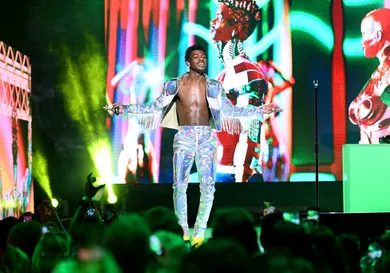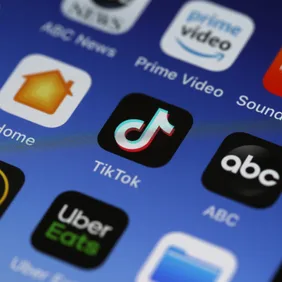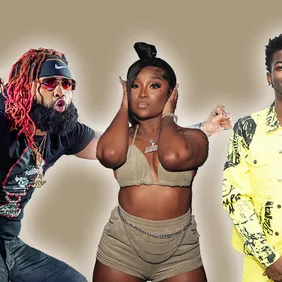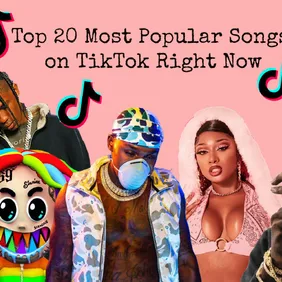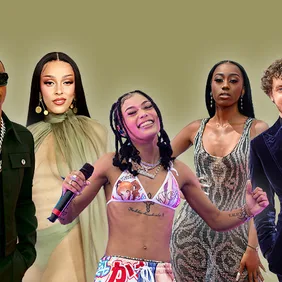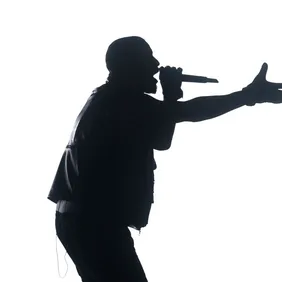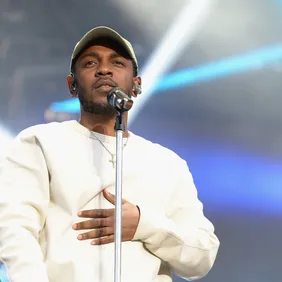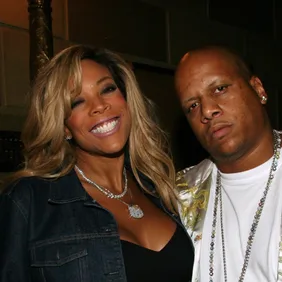“This is no accident, I’ve been pushing this hard,” Lil Nas X says. “The internet is basically like my parents in a way. I was raised picking up on stuff, and I learned how to use it in my own way.” The self-aware 20-year-old is of course talking about the auspicious start to his career as the face behind “Old Town Road,” now one of the biggest songs of all time that galloped its way from SoundCloud loosie to Billboard titan before eventually settling into a steady trot as the fluffy white noise of summer 2019. His is the kind of rapid, white-hot success reserved for music’s blossoming meme ecosystem, where meta opportunists and camp conceptualists scamper to collect internet scraps that will allow them to procure the latest and greatest version of virality.
Roy Rochlin/Getty Images for MTV
Lil Nas X’s retooling of modern celebrity has drawn attention to TikTok, the womb from which his Wrangler-wearing reckoning developed into an online El Dorado. With 500 million active monthly users, TikTok is one of the most-used social media apps in the world, outpacing mainstays such as Twitter and Snapchat. The platform got its start in September 2016, when Beijing-based parent company ByteDance, founded by Zhand Yiming, launched the app in China under the name Douyin. ByteDance, which boasts a multi-faceted empire that spans a dozen products available in 150 markets and 75 languages, is now the most valuable start-up on the planet at a lofty $75 billion. The company’s growth has been fueled by rabid strategic expansion: its 2018 acquisition of lip-sync app Musical-ly for a reported $1 billion allowed it to get its foot in the door of the trend-setting U.S. market. Although Douyin, internationally rebranded as “TikTok,” had already generated a significant following in the early stages of its lifespan, the surplus of users following the Musical.ly merger helped it reach over a billion downloads via the App Store and Google Play. A whopping 25% of these downloads can be attributed to India, a country of 1.4 billion people that represents a largely untapped market for the music industry. India is ready to make a splash in the developed world, and TikTok has been one of the first digital platforms to latch on: per Economic Times, “the number of people getting connected to internet in India through smartphones is all set to double to 600-650 million by 2020,” an astronomical figure that speaks to just how quickly the government will have to adapt to accommodate its increasingly technologically savvy populace.
From a business perspective, TikTik’s success is clearly no fluke. But what the app possesses beyond its global reach is something much more integral to its success: bite-sized cultural capital. It’s “popcorn entertainment” that can be consumed in the blink of an eye. Not only is TikTok’s 15-second video format ideal for shortening attention spans, but it’s engendered a music discovery treasure trove for smartphone users in an era of smartphone-first media consumption. Its easily-browsable “For You” page offers a personalized timeline that is curated by the app’s vaunted algorithm, a form of AI-targeted aggregation that is the thesis of ByteDance’s mission statement, and likely the future of online entertainment. TikTok’s targeted outreach efforts serve users the content that they want right away. The more you use it, the more familiar it becomes with your habits: your likes and comments, the speed at which you swipe, and how long you watch videos are taken into account. It all makes for a highly addictive experience, one that encourages participation in cultural flashpoints that establish a sense of community among disparate users, allowing them to consume and take part all at once. “Imagine a version of Facebook that was able to fill your feed before you’d friended a single person,” as The New York Times’ John Herrman aptly put it. “That’s TikTok.”
Joe Scarnici/Getty Images
Though initially ad-free, TikTok now supports a variety of advertising formats in an attempt to monetize its growing user base, and it has mobilized content creators in this pursuit. The app rewards creators for keeping audiences engaged and on the app, and popular creators have access to the Creators Program, which “have a very key part in pushing what (TikTok) wants to do.” TikTok has allegedly used monetary incentives to entice content creation: an artist who’s currently enjoying more than a million streams a day says TikTok reached out directly and paid the artist to make an account, promote it and post a video. TikTok can also add songs to their internal playlists (see their built-out song search hub, which allows users to soundtrack their videos using a massive library of officially licensed song snippets) and run banner ads with links to songs. The migration of users from TikTok to music streaming apps has not gone unnoticed, as spikes in traffic on TikTok frequently translate into streams. “Who’s here from TikTok?” litters YouTube comment sections, while Instagram hosts compilation pages that pay homage to TikTik’s “one-two punch of discovery and engagement.” Even TikTok-focused playlists have thousands of followers on Spotify and Apple Music (“tiktok songs that are stuck in my head” has well over 100 songs and more than 87,000 followers on Spotify).
Indeed, music is the uniting force for nearly every piece of content posted to TikTok. It’s what sets the mood and defines the objective of any given “challenge,” with audio being carefully handpicked to accompany the brevity and bombast of DIYs and dance crazes. “TikTok is an audio platform, whereby video is the medium used to express interest in the sound,” Max Bernstein, the founder of influencer marketing agency Musser, explained. “On TikTok, if you’re interested in a sound, you make a video to it, and the focus is on the sound.” Videos that perform well get elevated status, which aids in hashtag campaigns and trends taking off. “Songs and memes are like rockets and space shuttles,” DJ-rapper and relentless TikTok proponent Supa Dupa Humble said in an interview with The Ringer. “Obviously, the space shuttle needs the rocket to get to space, and then it breaks off. So that’s what the meme is.”
Once in orbit, everyone wants to climb aboard. Take the #OldTownRoad challenge, which is currently sitting at nearly 500 million collective views on TikTok. The song’s release in December 2018 coincided with TikTok’s Yeehaw challenge, in which users undergo surprise outfit changes to cosplay as men and women of the wild west. “Everyone was dressed like a cowboy for three weeks,” said influencer Michael Pelchat (@nicemichael), who was the first person to post “Old Town Road” on TikTok. It was the snowball effect playing out in revved up real-time, and it left the music industry scrambling: because there was no official release, radio stations began ripping the audio from YouTube to keep up with the song’s demand. Within the span of just a couple months, Lil Nas X had signed with Columbia Records (after the label’s president slid in his DMs), put out a star-studded music video to accompany the hit, and announced a brand collaboration with Wrangler.
This is the brilliance of the TikTok model: the ability to spark a song’s commercial success via crowdsourced spontaneity. It gets music in front of fans and bypasses traditional gatekeepers in the process, essentially acting as an A&R and publicity team rolled into one. Rather than being pre-engineered, the groundswell of enthusiasm makes for organic virality: artists can put the music out there, see what sticks, and let other people make the content for them. It’s a free-of-charge marketing campaign that continuously feeds itself, a completely uncharted and revolutionary viral space that represents a turning point for the entire music industry. Now, artists are asking "not what kind of platforms would be the best for (their) music, but what kind of music would be best for (their) platforms."
Social media has taken the music industry by storm, and TikTok is at the frontlines. It has succeeded in perpetuating the perception that 15 seconds is all it takes to achieve fully-fledged fame. Individual superstardom is well within reach, yes, but long term success for these flash-in-the-pan artists seems all the more tenuous as a result. For now, one song suffices as rocket fuel, as music industry professionals continue to unravel the intricacies of the TikTok formula. Predicting how new wave music will unfold, unlocking the full potential of the platform’s promotional value, and subsequently revamping marketing techniques will all be important pieces of the puzzle going forward. TikTok has also opened a Pandora’s box when it comes to the issue of licensing, collecting, and distributing royalties from digital platforms. The lack of a formalized and consistent structure to make sure that the money ends up in the correct pockets and in a timely fashion has created an imbalance of power. And given how much money is at stake, it seems as if it’s only a matter of time before the relevant players decide that exposure alone isn’t enough.
According to a report published in June by Bloomberg, the three major labels’ deals with TikTok expire soon, and they’re now pushing for more favorable terms. Though a long-term relationship seems beneficial for both sides, if talks stall, then the labels could potentially pull their catalogues from the app. Perhaps TikTok will launch its own music streaming service, further expanding its reach into music as it looks to crack more overseas markets. Who knows what the next iteration of TikTok will look like. “I would love to have a new platform every year that does this for the music business — reach new audiences, reach the kids,” said Jeff Vaughn, Senior VP of A&R at APG, in a recent piece published by Rolling Stone. “If you think of the music consuming demo as 11[-year-olds] to 24[-year-olds], you reach the bottom half of that audience through two platforms: YouTube and TikTok.” Whatever the case may be, the road ahead for the dynamic breeding ground of viral hits is full of endless possibilities and bountiful rewards that will continue to impact the evolution of pop music for years to come.
